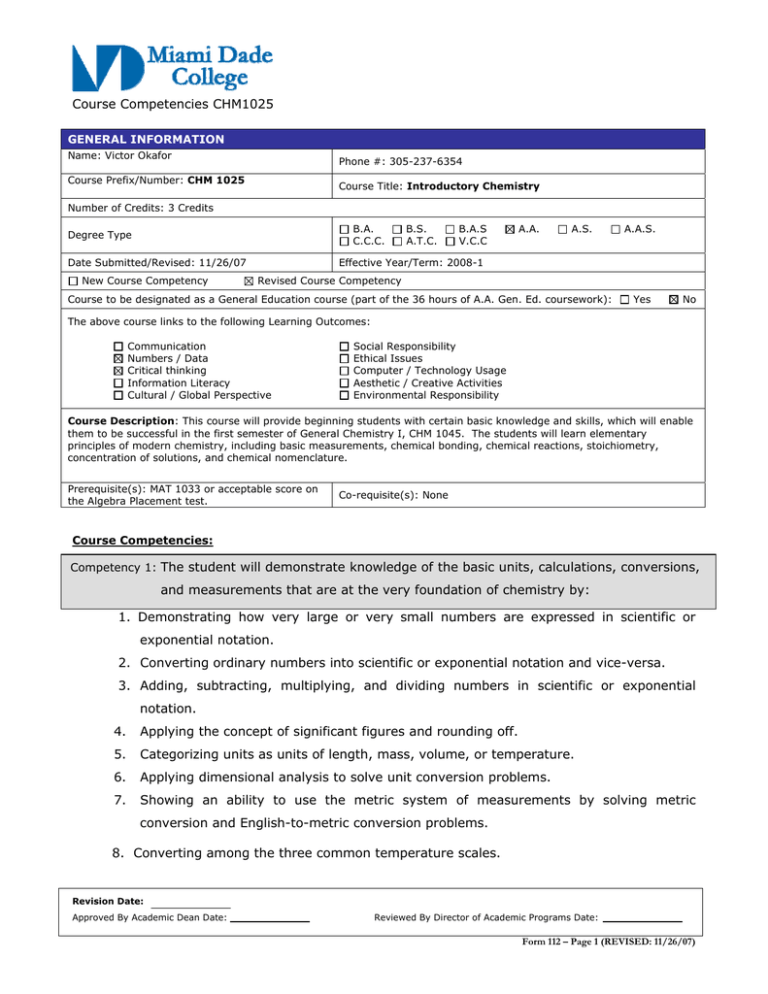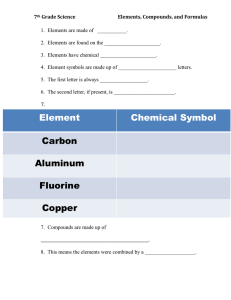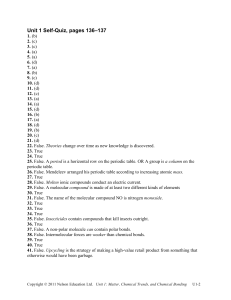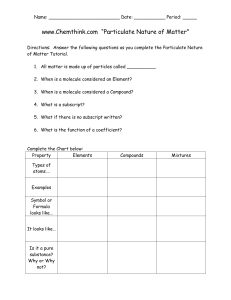Course Competencies CHM1025 1. Demonstrating how very large
advertisement

Course Competencies CHM1025 GENERAL INFORMATION Name: Victor Okafor Phone #: 305-237-6354 Course Prefix/Number: CHM 1025 Course Title: Introductory Chemistry Number of Credits: 3 Credits B.A. C.C.C. Degree Type Date Submitted/Revised: 11/26/07 New Course Competency B.S. A.T.C. B.A.S V.C.C A.A. A.S. A.A.S. Effective Year/Term: 2008-1 Revised Course Competency Course to be designated as a General Education course (part of the 36 hours of A.A. Gen. Ed. coursework): Yes No The above course links to the following Learning Outcomes: Communication Numbers / Data Critical thinking Information Literacy Cultural / Global Perspective Social Responsibility Ethical Issues Computer / Technology Usage Aesthetic / Creative Activities Environmental Responsibility Course Description: This course will provide beginning students with certain basic knowledge and skills, which will enable them to be successful in the first semester of General Chemistry I, CHM 1045. The students will learn elementary principles of modern chemistry, including basic measurements, chemical bonding, chemical reactions, stoichiometry, concentration of solutions, and chemical nomenclature. Prerequisite(s): MAT 1033 or acceptable score on the Algebra Placement test. Co-requisite(s): None Course Competencies: Competency 1: The student will demonstrate knowledge of the basic units, calculations, conversions, and measurements that are at the very foundation of chemistry by: 1. Demonstrating how very large or very small numbers are expressed in scientific or exponential notation. 2. Converting ordinary numbers into scientific or exponential notation and vice-versa. 3. Adding, subtracting, multiplying, and dividing numbers in scientific or exponential notation. 4. Applying the concept of significant figures and rounding off. 5. Categorizing units as units of length, mass, volume, or temperature. 6. Applying dimensional analysis to solve unit conversion problems. 7. Showing an ability to use the metric system of measurements by solving metric conversion and English-to-metric conversion problems. 8. Converting among the three common temperature scales. Revision Date: Approved By Academic Dean Date: Reviewed By Director of Academic Programs Date: Form 112 – Page 1 (REVISED: 11/26/07) 9. Defining density. 10. Performing density calculations. Competency 2: The student will demonstrate knowledge of matter’s classification, properties, and changes by: 1. Classifying matter as either a pure substance or mixture. 2. Classifying pure substances as either elements or compounds. 3. Classifying a mixture as either homogeneous or heterogeneous. 4. Distinguishing between the physical and chemical properties of matter. 5. Distinguishing between the physical and chemical changes that matter undergoes. 6. Characterizing the three common states of matter. 7. Applying the Law of Conservation of Matter. 8. Applying the Law of Conservation of Energy. Competency 3: The student will demonstrate knowledge of the basic building blocks of matter by: 1. Identifying the three major subatomic particles (electrons, protons, and neutrons) of the atom and describing their general arrangement within the atom. 2. Defining isotopes and determining how the properties and structure of various isotopes of a single element differ. 3. Relating an element’s isotopic abundance and mass to its average atomic mass. 4. Identifying the number of protons, neutrons, electrons, mass number, and atomic number that an atom has given its isotopic symbol. 5. Learning the names and symbols of several common elements. 6. Describing the formation of ions from their parent atoms, and learning their names. 7. Showing how atoms or ions combine to form compounds. 8. Identifying the basic repeating unit of elements (atom, molecule, or formula unit), ions (ion or formula unit), and compounds (molecule or formula unit). Revision Date: Approved By Academic Dean Date: Reviewed By Director of Academic Programs Date: Form 112 – Page 2 (REVISED: 11/26/07) Competency 4: The student will demonstrate an ability to understand several of the intricacies of the periodic table by: 1. Distinguishing between periods and groups on the periodic table. 2. Showing the relationship between position on the periodic table and atomic number. 3. Using the structure of the periodic table to classify elements (e.g., metal, non-metal, metalloid, noble gas, representative element, transition element, inner transition element, alkali metal, alkaline earth metal, and/or halogen). 4. Showing the relationship between elements having similar chemical properties and being in the same group. 5. Giving the reason for elements having similar chemical properties based upon their atomic structures. 6. Using the periodic table to identify common patterns such as atomic radii and electronegativity within periods and groups of elements. 7. Describing the relationship that exists between the number of valence electrons an element has and its group number. 8. Describing the relationship between an element’s group number and the ion that it commonly forms. 9. Identifying the s, p, d and f blocks in the periodic table. Competency 5: The student will demonstrate knowledge of electronic structure by: 1. Demonstrating the relationship that exists among wavelength, frequency, and energy of electromagnetic radiation. 2. Giving the maximum number of electrons that can be accommodated in the various energy levels, sublevels, and orbitals. 3. Applying Pauli’s Exclusion Principle and Hund’s Rule to construct electron orbital diagrams. 4. Writing electronic configurations for neutral atoms and ions. 5. Giving the number of valence electrons in an atom. 6. Relating electronic configurations to the position of elements in the periodic table. Revision Date: Approved By Academic Dean Date: Reviewed By Director of Academic Programs Date: Form 112 – Page 3 (REVISED: 11/26/07) Competency 6: The student will demonstrate knowledge of chemical bonding by: 1. Predicting the type of bond that two atoms will form. 2. Describing how and why ionic and covalent bonds form. 3. Describing the difference between polar and non-polar covalent bonds. 4. Defining electronegativity. 5. Predicting bond polarity by calculating the electronegativity differences of the elements involved in bonding. 6. Identifying the traits of ionic compounds and covalent compounds. 7. Writing the Lewis electron dot structure of elements, ions, ionic compounds, and covalent compounds. 8. Using the Valence Shell Electron-Pair Repulsion Theory to determine molecular geometry and bond angles of chemical species containing up to four pairs of valence electrons. Competency 7: The student will demonstrate knowledge of composition stoichiometry by: 1. Identifying what atoms are present in a compound and in what ratio. 2. Defining a mole. 3. Calculating the molar mass of a substance from the sum of its atomic masses. 4. Converting between mass, moles, and number of atoms or molecules in a sample of a substance. 5. Showing how to find the mass percent of an element in a given compound. 6. Using the mass percent to find the amount of an element in a given size sample of a compound. 7. Defining empirical formula. 8. Determining the empirical formula of a compound from elemental masses or mass percentages. 9. Determining the molecular formula of a compound given its empirical formula and molar mass. Revision Date: Approved By Academic Dean Date: Reviewed By Director of Academic Programs Date: Form 112 – Page 4 (REVISED: 11/26/07) Competency 8: The student will demonstrate knowledge of chemical reactions in relation to reaction stoichiometry by: 1. Balancing chemical equations. 2. Identifying out the significance of the coefficients in a balanced chemical equation. 3. Solving various stoichiometry problems. 4. Determining which reactant in a chemical reaction is the limiting reagent. 5. Using the limiting reagent concept in calculations. 6. Comparing the amount of substance actually formed in the reaction (actual yield) with the predicted amount (theoretical yield) to determine the percent yield of a chemical reaction. Competency 9: The student will demonstrate knowledge of the properties of solutions by: 1. Distinguishing between a solute and solvent in a solution. 2. Distinguishing between the different types of solutions: saturated, unsaturated, and supersaturated. 3. Defining the concentration of a solution in terms of mass percent and showing how to calculate it. 4. Defining the concentration of a solution in terms of molarity and showing how to calculate it. 5. Calculating the concentration of a solution made by dilution of a stock solution. Competency 10: The student will demonstrate knowledge of writing chemical formulas and chemical nomenclature of inorganic compounds by: 1. Determining the oxidation number of atoms in a neutral compound. 2. Determining the oxidation number of atoms in a polyatomic ion. 3. Naming common polyatomic ions given their formulas. 4. Writing the formula of common polyatomic ions given their names. 5. Distinguishing between binary compounds and ternary compounds. 6. Using oxidation numbers to write formulas of binary and ternary compounds. 7. Distinguishing between metals with one oxidation number and metals with variable oxidation numbers. 8. Naming a binary metal, non-metal compound given its formula. Revision Date: Approved By Academic Dean Date: Reviewed By Director of Academic Programs Date: Form 112 – Page 5 (REVISED: 11/26/07) 9. Writing the formula of a binary metal, non-metal compound given its name. 10. Naming a compound containing a metal and a polyatomic ion given its formula. 11. Writing the formula of a compound containing a metal and a polyatomic ion given its name. 12. Naming a compound containing only non-metals given its formula. 13. Writing the formula of a compound containing only non-metals given its name. 14. Naming a binary acid given its formula. 15. Writing the formula of a binary acid given its name. 16. Naming an oxo-acid given its formula. 17. Writing the formula of an oxo-acid given its name. Competency 11: The student will demonstrate knowledge of some of the various aspects of chemical reactions by: 1. Categorizing chemical reactions (e.g. combination, decomposition, single replacement, and double replacement). 2. Showing how the solubility rules and electromotive series are used to predict whether or not a chemical reaction will occur. 3. Using the rules of solubility as a means of determining the physical state of substances involved in aqueous chemical reactions. 4. Writing chemical equations in molecular, ionic, and net ionic form. Revision Date: Approved By Academic Dean Date: Reviewed By Director of Academic Programs Date: Form 112 – Page 6 (REVISED: 11/26/07)



